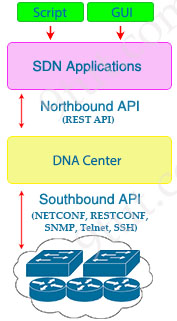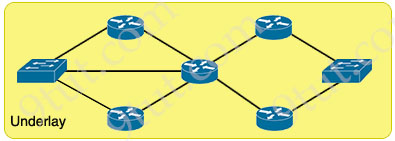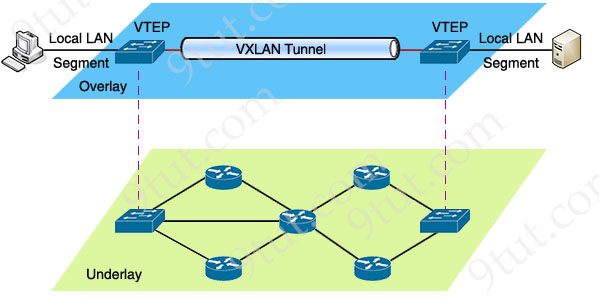DNA Center Questions
|
DNA Center Quick Summary Software-Defined Access (SDA) uses the software-defined architectural model, with a controller and various APIs. At the center sits the Digital Network Architecture (DNA) Center controller.
DNA Center is the controller for SDA networks. DNA Center uses REST APIs on Northbound interface. On Southbound interface, DNA Center uses various protocols like RESTCONF, NETCONF etc. The southbound side of the controller contains the fabric, underlay, and overlay: Overlay: The mechanisms to create VXLAN tunnels between SDA switches, which are then used to transport traffic from one fabric endpoint to another over the fabric.
Underlay: The network of devices and connections (cables and wireless) to provide IP connectivity to all nodes in the fabric, with a goal to support the dynamic discovery of all SDA devices and endpoints as a part of the process to create overlay VXLAN tunnels.
The relationship between Overlay and Underlay is shown below:
Fabric: The combination of overlay and underlay, which together provide all features to deliver data across the network with the desired features and attributes Reference: CCNA 200-301 Official Cert Guide Cisco DNA Center is a software solution that resides on the Cisco DNA Center appliance. The solution receives data in the form of streaming telemetry from every device (switch, router, access point, and wireless access controller) on the network. This data provides Cisco DNA Center with the real-time information it needs for the many functions it performs. Cisco DNA Center collects data from several different sources and protocols on the local network, including the following: traceroute; syslog; NetFlow; Authentication, Authorization, and Accounting (AAA); routers; Dynamic Host Configuration Protocol (DHCP); Telnet; wireless devices; Command-Line Interface (CLI); Object IDs (OIDs); IP SLA; DNS; ping; Simple Network Management Protocol (SNMP); IP Address Management (IPAM); MIB; Cisco Connected Mobile Experiences (CMX); and AppDynamics. Cisco DNA Center offers 360-degree extensibility through four distinct types of platform capabilities: + Intent-based APIs leverage the controller and enable business and IT applications to deliver intent to the network and to reap network analytics and insights for IT and business innovation. The Intent API provides policy-based abstraction of business intent, allowing focus on an outcome rather than struggling with individual mechanisms steps. For example, the administrator configures the intent or outcome desired of a set of security polices. The DNA Center then communicates with the devices to determine exactly the required configuration to achieve that intent. Then the complete configuration is sent down to the devices. |
Question 1
Explanation
Cisco DNA Center offers 360-degree extensibility through four distinct types of platform capabilities:
+ Intent-based APIs leverage the controller and enable business and IT applications to deliver intent to the network and to reap network analytics and insights for IT and business innovation.
+ Process adapters, built on integration APIs, allow integration with other IT and network systems to streamline IT operations and processes.
+ Domain adapters, built on integration APIs, allow integration with other infrastructure domains such as data center, WAN, and security to deliver a consistent intent-based infrastructure across the entire IT environment.
+ SDKs allow management to be extended to third-party vendor’s network devices to offer support for diverse environments.
Question 2
Question 3
Explanation
Cisco DNA Center is a software solution that resides on the Cisco DNA Center appliance. The solution receives data in the form of streaming telemetry from every device (switch, router, access point, and wireless access controller) on the network. This data provides Cisco DNA Center with the real-time information it needs for the many functions it performs.
Cisco DNA Center collects data from several different sources and protocols on the local network, including the following: traceroute; syslog; NetFlow; Authentication, Authorization, and Accounting (AAA); routers; Dynamic Host Configuration Protocol (DHCP); Telnet; wireless devices; Command-Line Interface (CLI); Object IDs (OIDs); IP SLA; DNS; ping; Simple Network Management Protocol (SNMP); IP Address Management (IPAM); MIB; Cisco Connected Mobile Experiences (CMX); and AppDynamics.
Question 4
Explanation
With Intent-based APIs, the administrator configures the intent or outcome desired of a set of security polices. The DNA Center then communicates with the devices to determine exactly the required configuration to achieve that intent. Then the complete configuration is sent down to the devices -> This helps reduce time to deploy a network compare to the traditional networks.
Question 5







1 and 2 are repeated
Hi @9tut,
Question 3
What makes Cisco DNA Center different from traditional network management applications and their management of networks?
Answer: c
answer C is correct?
answer B :It modular design allows someone to implement different versions to meet the specific needs of an organization why couldn’t it be the correct answer?
Which two capacities of Cisco DNA Center make it more extensible? (Choose two)
A. adapters that support all families of Cisco IOS software
B. SDKs that support interaction with third-party network equipment
C. customized versions for small, medium, and large enterprises
D. REST APIs that allow for external applications to interact natively with Cisco DNA Center E. modular design that is upgradable as needed
BD
Hi @9tut
Q3. I would say option”B” is kind of more correct?
@9tut
I think Q4 C is correct.
Please check the question.
@Shiva: DNA Center is not a cheap solution so it cannot be implemented at a lower cost than most traditional campus device management options.
@9tut
Thanks for your explanation.
DNA center topic in CCNA cert is more like cisco promotion than a real need for CCNA level knowledge
Hi @9tut,
Does this questions change after February of each year or if there’s any new questions you guys will add them here?
who know DNAAS ? Leveraging Cisco Intent-Based Networking DNA Assurance ?